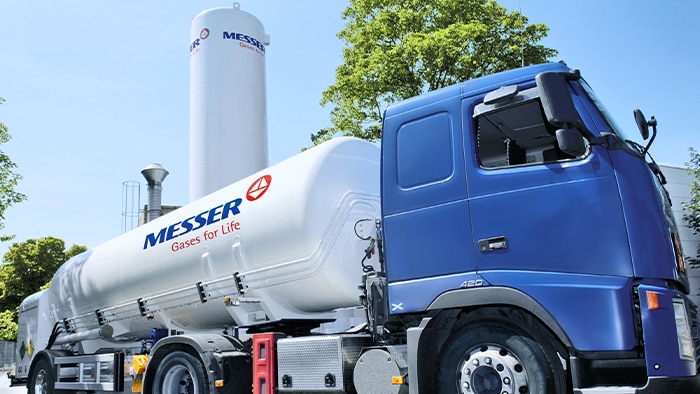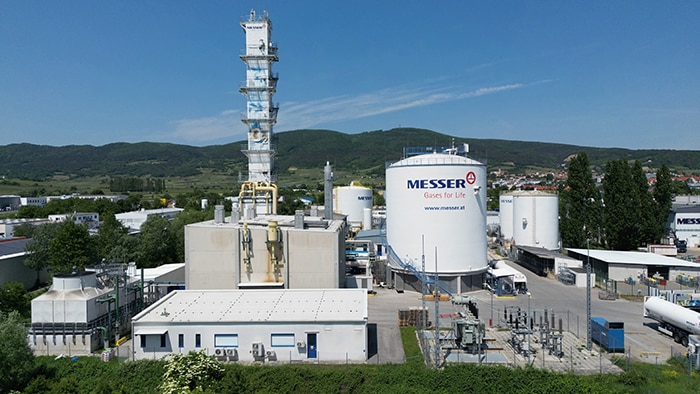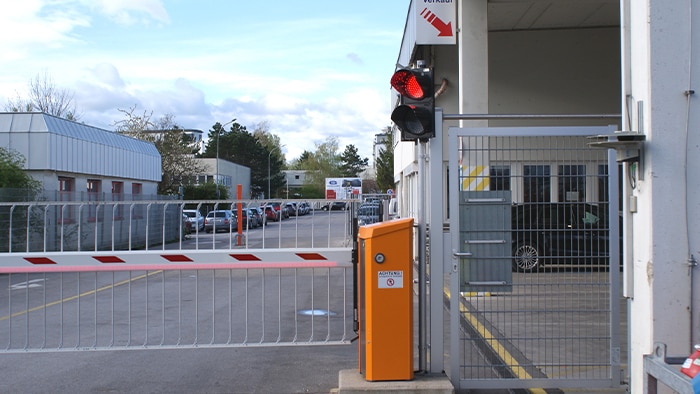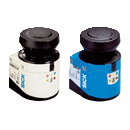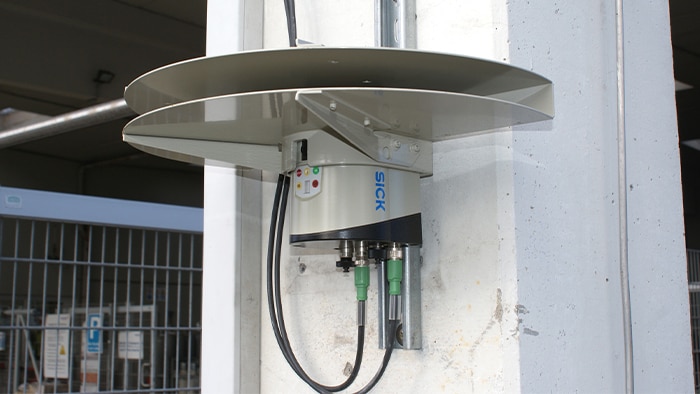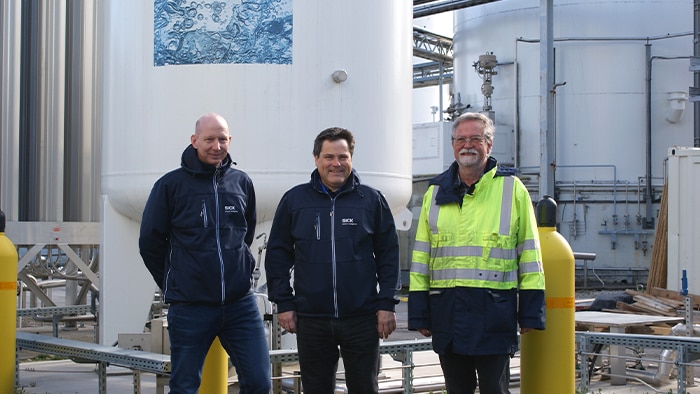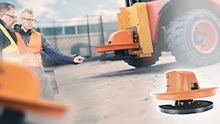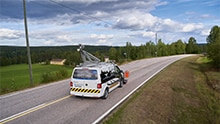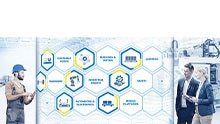Messer Austria in Gumpoldskirchen, Lower Austria produces gases for a range of applications from industry to medicine. There are many potential hazards at the site, so the company has to minimize all kinds of risks. Controlling the movement of vehicles onto and off the premises is an important part of this. A fully automated barrier control using a LiDAR sensor ensures only trucks can drive along a particular thoroughfare on the site. The barrier remains closed for cars and other unauthorized road users.
All clear for trucks – fully automated barrier control using 2D LiDAR technology
The function of a barrier is comparable to that of a goalkeeper in football. He makes sure that nothing gets through that isn’t supposed to. When the goalie messes up, however, because he didn’t realize that a ball was flying towards his goal and simply lets it pass, this doesn't exactly bring a smile to the spectator’s faces – at least not among their own fans. A similar thing happened to Christian Bücker at Messer Austria with an unreliable barrier that had not brought much cause for celebration over many years. False openings kept happening from time to time. The reason: The smart sensor for vehicle detection was not really that smart in practice – a not so desirable circumstance, of course, when there are hazardous substances around.
Gas as a safety hazard
The production, storage and transport of gases often comes with considerable potential risks. The safety requirements here are therefore particularly stringent. That is why every visitor to the premises of Messer immediately receives a safety briefing. Christian Bücker is responsible for looking after, maintaining and optimizing the gas specialist's systems. ”Gases are too often underestimated because you can’t see them and because the danger can also creep up on you. That makes special precautionary measures necessary,” explains the measurement and control engineer.
Highly sensitive substances
The Gumpoldskirchen plant manufactures in particular industrial gases and food and medical gases. Christian Bücker: “Food gases include, in particular, CO2 and nitrogen – the medical gases produced here are oxygen and nitric oxide (NO). NO is mainly used for the treatment of respiratory problems. Most air gases that we manufacture and store here in our plant are more or less inert and thus fairly unreactive.” That doesn't preclude the presence of risks, however. Oxygen, for example, while not dangerous in principle, is however an oxidizing agent.
Safe transport
Due to the sensitive products that are produced at Messer, the company needs to control the traffic on its site. As the main arrivals and departures of vehicles are processed at a single gate, this is a demanding undertaking. Christian Bücker: “There is also a customer area on the site. We therefore need to separate the heavy traffic – which has to drive far onto the site – from customer cars. We therefore set up a fully automated barrier system at the plant site that is intended to allow trucks through but not cars, forklift trucks and pedestrians. Which is not exactly easy to do, as around 20 years of experience has shown. We kept trying out new technical solutions from different suppliers – nothing really worked satisfactorily. False openings and faults kept occurring. That's why we turned to the sensor specialist SICK last year, who surprised us with a perfect solution.”
Automated gatekeeper
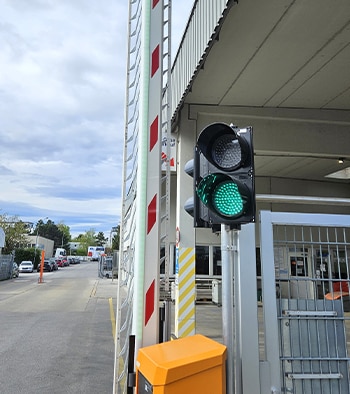
"The barrier system needs to open as few times as possible but as often as necessary – namely whenever a truck approaches,” explains Christian Bücker. The system uses an LMS1xx 2D LiDAR sensor that features a field evaluation with flexible fields. Similar sensors from the 2D LiDAR family are often used on autobahns for Vehicle Hotspot Detection (VHD), where they detect the size of a vehicle and create a cross-sectional model of every truck. What temperature range the vehicle falls into is determined using a thermal camera. If the brakes of the truck are overheating or there is a problem with the load, then the truck will be prevented, for example, from entering a tunnel. The situation and requirements at the Gumpoldskirchen plant are completely different, however.
Joint tests were convincing
Ulrich Wasinger, Market Product Specialist at SICK Austria: “We wanted to make sure that the LiDAR sensor is the right solution for this application and our specific environment in particular – there are 120 kV electrical cables running under the road – and all settings on the device work perfectly. That’s why we spent a whole day performing calibrations on trucks, cars, forklift trucks and pedestrians with the assistance of Messer. It paid off – the results were convincing”.
Ingo Wegscheider, Regional Sales Manager at SICK Austria: “On the LMS131, you can preconfigure a blanking size on the sensor. At the same time, it is also possible to define vehicles according to their size. Both length and width are detected for this purpose. A switching instruction is only sent to the barrier if the vehicle is higher or wider than 1.8 meters.” Christian Bücker: “The sensor is configured so that no forklift trucks are let through. In the event that a larger transport of goods to the customer parking area is necessary, the forklift truck driver can still open the barrier by means of a radio signal.”
Clear view in wind and weather
As part of the long-term testing at Messer, the capability of the sensor in fog, rain, snowfall and with reflections from sunlight and headlights was checked over an entire winter. Here too the 2D LiDAR sensor always maintained a “clear view” and reliably demonstrated its advantages compared to other technologies – for example cameras. That earned it a big “thumbs up” from Messer – the LMS131 was then “officially” ordered on account of its convincing performance. The solution has now been in use at Messer for almost a year and Christian Bücker is full of praise: “I can say that the solution from SICK works flawlessly, regardless of the weather. We have not established any false barrier openings to-date. I am very happy that the ongoing ‘barriers’ issue has thereby finally been successfully resolved.”
